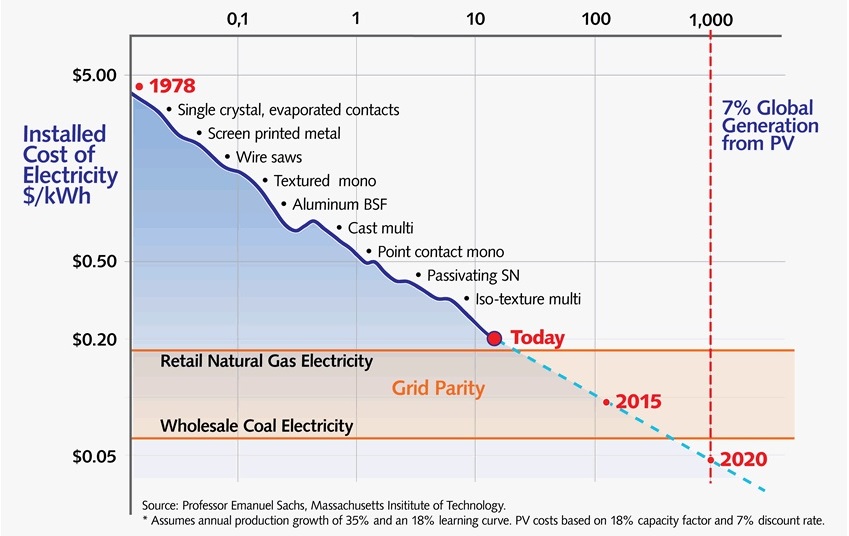This Friday marks the 60th anniversary of the first demonstration of a photovoltaic cell converting solar energy into electricity. Bell Laboratory engineers Daryl Chapin, Calvin Fuller, and Gerald Pearson displayed this breakthrough technology at a press conference on April 25th, 1954. Until then, light had never been converted into electricity to generate any useful amount of power. The following day, The New York Times proclaimed this discovery to be “the beginning of a new era, leading eventually to the realization of one of mankind’s most cherished dreams – the harnessing of the almost limitless energy of the sun for the uses of civilization.”
The first market for solar photovoltaic (PV) cells was spacecraft, which used the cells to extend the lifespan of satellites beyond the limits of batteries. In the following decades, companies expanded the application of solar to provide power in remote locations such as offshore oil and gas rigs or lighthouses. The establishment of federal laboratory facilities and R&D programs in the 1970s and 1980s helped bring solar energy technologies to the scale at which it is today. Now, countless organizations and companies (even Google) are involved in the finance for and installation of solar PV projects around the world.
So how much has really happened with solar cells in the last six decades? To start, more than 135 gigawatts of solar PV are now installed around the world, 37 of which were installed just last year. That’s enough energy to power every household in the United States and then some. This is an astonishing rate of commercialization considering that, just three decades ago, barely more than 20 megawatts of solar PV capacity existed. Indeed, it wasn’t until 1999 that the first gigawatt of solar PV capacity was installed. Economies of scale have brought the cost of solar PV from over $1,000/watt for NASA’s first cell purchases in the 1950s, down to less than $5/watt for residential, commercial, and utility-scale solar PV.
With these dramatic cost declines, markets in which solar is cost-competitive with conventional power sources are beginning to emerge. In Germany and Italy, solar power has already become as cheap as electricity produced from coal or gas. With conventional energy prices predicted to rise in future years, solar is well on its way to becoming cost-competitive in many other countries as well. In the United States, government policies and programs have also helped to make solar energy more affordable. In recent years, federal tax credits and DOE loan guarantee programs have incentivized the installation of utility-scale solar. Residential- and commercial-installed solar energy has proliferated, in part, as a result of programs such as rebates, third-party financing, commercial property-assessed clean energy financing, and more.
Solar’s future is bright: though the technology is being adopted rapidly, it still only provides less than1 percent of global energy demand. But there is a huge market into which solar can expand. It is a limitless resource, and in an increasingly resource-constrained world, more and more power will need to be derived from sustainable sources like solar.
Featured image courtesy of Greentech Media Solar

